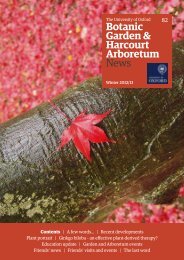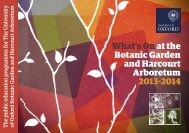The University of Oxford Botanic Garden News - Harcourt Arboretum
The University of Oxford Botanic Garden News - Harcourt Arboretum
The University of Oxford Botanic Garden News - Harcourt Arboretum
- No tags were found...
Create successful ePaper yourself
Turn your PDF publications into a flip-book with our unique Google optimized e-Paper software.
8<strong>Botanic</strong> <strong>Garden</strong> <strong>News</strong> | No. 77<strong>The</strong> ancient art <strong>of</strong>charcoal productionat <strong>Harcourt</strong> <strong>Arboretum</strong>by MalcolmRutherfordMalcolm Rutherford is originally from New Zealand and is a trainee at the<strong>Botanic</strong> <strong>Garden</strong>. He studied botany at university and later worked in rarebird conservation in New Zealand with the Kakapo and various seabirds,and taught ecology at Fota Wildlife Park in Ireland.It is half past five on a Wednesday inDecember. <strong>The</strong> sky is clear and thetemperature is around minus four.Buses don’t run at this time <strong>of</strong> day so I’mwaiting to be picked up by Guy, an arborist at<strong>Harcourt</strong> <strong>Arboretum</strong>. He is delayed a little bysnow but soon arrives and we are on our wayto Nuneham Courtenay. <strong>The</strong> time has cometo create some charcoal.Charcoal production is an ancient craftwhich, through the centuries, has led tosignificant steps forward in civilization.Charcoal burns at a hotter temperaturethan wood so was used to smelt metal frommined ore. This was first carried out on alarge scale in the Bronze Age. Improvementsin the efficiency <strong>of</strong> burning charcoal allowedhotter temperatures to be reached so thatharder metals like iron and alloys such asbrass could be smelted.Metal working relied on charcoaluntil a process to turn coal into coke wasdeveloped in 1735; within 100 years charcoalproduction in Great Britain had declinedArborist Guy Horwood tends the charcoal kilnsignificantly, despite the development<strong>of</strong> new uses for charcoal as horticulturalgrowing media, filtration media and as amedicine. Production was at its lowest pointin the mid 1980s but there has now beenan increase with the recent renaissance inwoodland crafts.By the time we arrive at the charcoal kiln,Karl (the other arborist at the <strong>Arboretum</strong>)has already started a bonfire which isa welcome source <strong>of</strong> heat on this crispmorning. Once there is a glowing pile <strong>of</strong>embers we start to shovel these into atrench we have dug around the base <strong>of</strong> thekiln. <strong>The</strong> kiln is a large drum about 6 feet indiameter with a slightly peaked lid and airvents around the base. <strong>The</strong> previous day westacked it with wood from a recently felledtree, leaving air channels in a star shapeon the bottom and a space up the middleto allow air and heat to circulate evenlythroughout the stack. Some <strong>of</strong> the woodsoon catches alight and a huge amount <strong>of</strong>steamy smoke starts to come out <strong>of</strong> the kilnMalcolm Rutherfordas water is driven out <strong>of</strong> the wood. <strong>The</strong> steamrising is mirrored by large flakes <strong>of</strong> snowwhich have started to fall.Charcoal is produced by heating organicmatter in a low-oxygen environment. Thisdrives <strong>of</strong>f the water and other volatilecompounds leaving the carbon skeleton <strong>of</strong>the plant. If burning is too rapid then thewood will burn away leaving a kiln full <strong>of</strong> ash,and if it is too slow then dry, slightly charredwood is left. To find the right balance we haveto control the amount <strong>of</strong> air entering the kilnthroughout the day by putting the lid on thekiln and blocking up the gap around the base.<strong>The</strong>re are six vents, three <strong>of</strong> which we turninto chimneys by adding tall pipes and three<strong>of</strong> which we leave as air intakes. Over thenext ten hours we check the embers burningthroughout the base <strong>of</strong> the kiln, adjusting theairflow as necessary. Ideally we would staywith the kiln until the smoke changes fromwhite to blueish grey. Unfortunately we aren’tcamping on site so we have to leave beforethis occurs, when the sun has gone down andthe working day is over. We block up all thevents to stop any oxygen from entering thekiln; now we have to wait a few days to seethe outcome <strong>of</strong> the burn.<strong>The</strong> production <strong>of</strong> charcoal is one <strong>of</strong>the most damaging practices in the world,responsible for deforestation, poor publichealth and greenhouse gas emissions. Anestimated 40 million tons <strong>of</strong> charcoal areproduced worldwide each year, half <strong>of</strong> themin Africa. In approximately 70% <strong>of</strong> EastAfrican homes charcoal is the sole energysource because electricity and fossil fuelsare unavailable or too expensive. Charcoal is<strong>of</strong>ten produced and burned very inefficiently,and smoke and carbon monoxide fromcooking on indoor charcoal, wood, and dungfires cause an estimated 400,000 deaths(mainly <strong>of</strong> women and children) in subSaharan Africa every year. <strong>The</strong>re are currentlyinitiatives trying to address these problems






